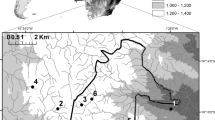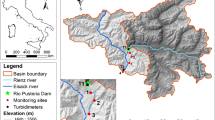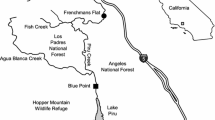Abstract
A number of aquatic organisms have demonstrated an ability to modulate sediment deposition in tropical and temperate stream systems, but little is known about the impact of similar benthic grazing processes in temperate pond systems. Using exclosure experiments in mesocosms, we used tadpoles of the western toad (Anaxyrus boreas) to investigate two questions: (1) can grazing activities of tadpoles of the western toad in ponds reduce sediment accrual on grazing surfaces (e.g. via bioturbation or ingestion); and (2) do these grazing activities contribute to enhanced periphyton biomass and chlorophyll a content of benthic matter. Mesocosms received pulses of fine sediment weekly over 8 weeks to simulate allochthonous surface inputs following rainstorms. Accumulated sediment and periphyton matter on exposed and grazing-restricted substrate surfaces were measured weekly. Tadpole grazing activity significantly reduced the standing stock of periphyton on open grazing surfaces by 80% in controls. Under sediment-additions, tadpoles effectively removed settled particulate matter from exposed grazing surfaces, but no corresponding increase in periphyton biomass was observed. These results suggest that tadpoles can impact the dynamics of sediment distribution in ponds as well as streams, providing support for a role as “ecosystem engineers” in these habitats.




Similar content being viewed by others
References
Barnett HK, Richardson JS (2002) Predation risk and competition effects on the life-history characteristics of larval Oregon spotted frog and larval red-legged frog. Oecologia 132:436–444
Beiswenger RE (1975) Structure and function in aggregations of tadpoles of the American toad, Bufo americanus. J Herpetol 31:222–233
Blaustein AR (1988) Ecological correlates and potential functions of kin recognition and kin association in anuran larvae. Behav Genet 18:449–464
Cecil SG, Just JJ (1979) Survival rate, population density and development of a naturally occurring anuran larvae (Rana catesbeiana). Copeia 1979:447–453
Creed RP Jr, Reed JM (2004) Ecosystem engineering by crayfish in a headwater stream community. J N Am Benthol Soc 23:224–236
De Souza ML, Moulton TP (2005) The effects of shrimps on benthic material in a Brazilian island stream. Freshw Biol 50:592–602
Dickman M (1968) The effect of grazing by tadpoles on the structure of a periphyton community. Ecology 49:1188–1190
Flecker AS (1992) Fish trophic guild and the structure of a tropical stream: weak direct versus strong indirect effects. Ecology 73:927–940
Flecker AS (1996) Ecosystem engineering by a dominant detritivore in a diverse tropical stream. Ecology 77:1845–1854
Flecker AS, Feifarek BP, Taylor BW (1999) Ecosystem engineering by a tropical tadpole: density-dependent effects on habitat structure and larval growth rates. Copeia 1999:495–500
Gyug L (1996) Part IV Amphibians. In: Timber harvesting effects on riparian wildlife and vegetation in the Okanagan Highlands of British Columbia. B.C. Environment, Penticton, BC
Johannsson OE, Dermott RM, Feldkamp R, Moore JE (1985) Lake Ontario long term biological monitoring program: report for 1981 and 1982. Can Tech Rep Fish Aquat Sci No. 1414
Jones CG, Lawton JH, Shachak M (1994) Organism as ecosystem engineers. Oikos 69:373–386
Katz LC, Potel MJ, Wassersug RJ (1981) Structure and mechanisms of schooling in tadpoles of the clawed frog, Xenopus laevis. Anim Behav 29:20–33
Ketcheson GL, Megahan WF, King JG (1999) “R1–R4” and “BOISED” sediment prediction model tests using forest roads in granitics. J Am Wat Res Assoc 35:83–98
Kupferberg S (1997) Facilitation of periphyton production by tadpole grazing: functional differences between species. Freshw Biol 37:427–439
Lamberti GA, Gregory SV, Hawkins CP, Wildman RC, Ashkenas LR, Denicola DM (1992) Plant–herbivore interactions in streams near Mount St. Helens. Freshw Biol 27:237–247
Littell RC, Stroup WW, Freund RJ (2002) SAS for linear models. SAS Institute, Cary, NC
Loman J (2001) Effects of tadpole grazing on periphytic algae in ponds. Wetlands Ecol Manage 9:135–139
Luo HR, Smith LM, Allen BL, Haukos D (1997) Effects of sedimentation on playa wetland volume. Ecol Appl 7:247–252
Martin DB, Hartman WA (1987) The effect of cultivation on sediment composition and deposition in prairie potholes. Water Air Soi Pollut 34:45–53
Meredith MP, Stehman SV (1991) Repeated measures experiments in forestry: focus on analysis of response curves. Can J For Res 21:957–965
Moulton TP, de Souza ML, Silveira RML, Kruslovic FAM (2004) Effects of ephemeropterans and shrimps on periphyton and sediments in a coastal stream (Atlantic forest, Rio de Janeiro, Brazil). J N Am Benthol Soc 3:868–881
Newcombe CP, MacDonald DD (1991) Effects of suspended sediments on aquatic ecosystems. N Am J Fish Manage 11:72–82
Paetzhold A, Schubert CJ, Tockner K (2005) Aquatic terrestrial linkages along a braided-river: riparian arthropods feeding on aquatic insects. Ecosystems 8:748–759
Polis GA, Anderson WB, Holt RD (1997) Toward an integration of landscape and food web ecology: the dynamics of spatially subsidized food webs. Annu Rev Ecol Syst 28:289–316
Potvin C, Lechowicz MJ, Tardiff S (1990) The statistical analysis of ecophysiological response curves obtained from experiments involving repeated measures. Ecology 71:1389–1400
Power ME (1990) Resource enhancement by indirect effects of grazers: armoured catfish algae and sediment. Ecology 71:897–904
Pringle CM, Blake GA, Covich AP, Buzby KM, Finley A (1993) Effects of omnivorous shrimp in a montane tropical stream: sediment removal, disturbance of sessile invertebrates, and enhancement of understory algal biomass. Oecologia 93:1–11
Ranvestel AW, Lips KR, Pringle CM, Whiles MR, Bixby RJ (2004) Neotropical tadpoles influence stream benthos: evidence for the ecological consequences of decline in amphibian populations. Freshw Biol 49:274–285
Relyea RA, Hoverman JT (2003) The impact of larval predators and competitors on the morphology and fitness of juvenile treefrogs. Oecologia 134:596–604
Richardson JS, Zhang Y, Marczak LB (2010) Resource subsidies across the land-freshwater interface and responses in recipient communities. River Res Appl 26:55–66. doi:10.1002/rra.1283
Samollow PB (1980) Selective mortality and reproduction in a natural population of Bufo boreas. Evolution 34:18–19
Seale DB (1980) Influence of amphibian larvae on primary production, nutrient flux, and competition in a pond ecosystem. Ecology 61:1531–1550
Shaw EA, Richardson JS (2001) Effects of fine inorganic sediment on stream invertebrate assemblages and rainbow trout (Oncorhynchus mykiss) growth and survival: implications of exposure duration. Can J Fish Aquat Sci 58:2213–2221
Solomon CT, Flecker AS, Taylor BW (2004) Testing the role of sediment-mediated interactions between tadpoles and armored catfish in a neotropical stream. Copeia 2004:610–616
Sontag C, Sloan-Wilson D, Cox RS (2006) Social foraging in Bufo americanus tadpoles. Anim Behav 72:1451–1456
Swift LW Jr (1988) Forest access roads: design, maintenance, and soil loss. In: Swank WT, Crossley DA Jr (eds) Forest hydrology and ecology at Coweeta. Springer, New York, pp 313–324
Thomas S, Gaiser EE, Tobias FA (2006) Effects of shading on calcareous benthic periphyton in a short-hydroperiod oligotrophic wetland (Everglades, FL, USA). Hydrobiol 569:209–221
Turnipseed G, Altig R (1975) Population density and age structure of three species of Hylid tadpoles. J Herpetol 9:287–291
Vadeboncoeur Y, Kalff J, Christoffersen K, Jeppesen E (2006) Substratum as a driver of variation in periphyton chlorophyll and productivity in lakes. J N Am Benthol Soc 25:379–392
Wassersug R (1973) Aspects of social behaviour in anuran larvae. In: Vial JL (ed) Evolutionary biology of the Anurans. University of Missouri Press, Columbia, pp 273–297
Waters TF (1995) Sediment in streams: sources, biological effects, and control. Am Fish Soc Monogr 7, Bethesda
Welch BL (1938) The significance of differences between two means when the population variances are unequal. Biometrika 29:350–362
Wood SLR, Richardson JS (2009) Impact of sediment and nutrient inputs on growth and survival of tadpoles of the Western Toad. Freshw Biol 54:1120–1134
Zhang Y, Richardson JS, Negishi J (2004) Detritus processing, ecosystem engineering, and benthic diversity: a test of predator-omnivore interference. J Anim Ecol 73:756–766
Acknowledgments
Thank you very much to Nancy Hofer, Aya Reiss, Isabelle Deguise, Mona Matson, Ashlee Alford and Dorota Klimek for their assistance in the field, and to Peter Arcese and Laurie Marczak for their valuable comments. We also thank British Columbia Provincial Parks, in particular Hugh Akroyd at Alice Lake Provincial Park, for permission and ready access to park facilities and to Mark Bomford for coordination at University of British Columbia South Campus. We would like to also thank the reviewers for their helpful comments. Animals involved in this study were handled in accordance with the Canadian Animal Care Committee, approved protocol A06-0080 from the University of British Columbia. We are grateful for funding supplied by the Forest Sciences Program (British Columbia) and a National Science and Engineering Research Council scholarship to S.Wood. All experiments carried out complied with the laws of Canada.
Author information
Authors and Affiliations
Corresponding author
Rights and permissions
About this article
Cite this article
Wood, S.L.R., Richardson, J.S. Evidence for ecosystem engineering in a lentic habitat by tadpoles of the western toad. Aquat. Sci. 72, 499–508 (2010). https://doi.org/10.1007/s00027-010-0151-x
Received:
Accepted:
Published:
Issue Date:
DOI: https://doi.org/10.1007/s00027-010-0151-x




